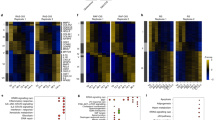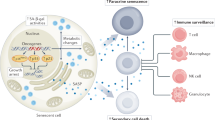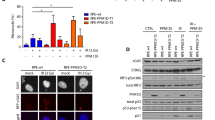Abstract
Oncogene-induced senescence is a mechanism of tumor suppression that restricts the progression of benign tumors. Important advances have been made toward elucidating the mechanisms that regulate this response; however, there is presently no unified model that integrates all current findings. DNA damage, replicative stress, reactive oxygen species, heterochromatin formation and negative feedback signaling networks have all been proposed to play an integral role in promoting senescence in response to various oncogenic insults. In all cases, these signals have been shown to function through Rb and p53, but utilize different intermediaries. Thus, it appears that senescence is not triggered by a single, linear series of events, but instead is regulated by a complex signaling network. Accordingly, multiple proteins may cooperate to establish a senescence response, but the limiting signal(s) may be dictated by the initiating genetic alteration and/or tissue type. This review will focus on integrating current models and will highlight data that provide new insight into the signals that function to suppress human tumor development.
This is a preview of subscription content, access via your institution
Access options
Subscribe to this journal
Receive 50 print issues and online access
$259.00 per year
only $5.18 per issue
Buy this article
- Purchase on SpringerLink
- Instant access to full article PDF
Prices may be subject to local taxes which are calculated during checkout


Similar content being viewed by others
References
Adams PD . (2007). Remodeling of chromatin structure in senescent cells and its potential impact on tumor suppression and aging. Gene 397: 84–93.
Bartkova J, Rezaei N, Liontos M, Karakaidos P, Kletsas D, Issaeva N et al. (2006). Oncogene-induced senescence is part of the tumorigenesis barrier imposed by DNA damage checkpoints. Nature 444: 633–637.
Basu TN, Gutmann DH, Fletcher JA, Glover TW, Collins FS, Downward J . (1992). Aberrant regulation of ras proteins in malignant tumour cells from type 1 neurofibromatosis patients. Nature 356: 713–715.
Brachmann SM, Yballe CM, Innocenti M, Deane JA, Fruman DA, Thomas SM et al. (2005). Role of phosphoinositide 3-kinase regulatory isoforms in development and actin rearrangement. Mol Cell Biol 25: 2593–2606.
Braig M, Lee S, Loddenkemper C, Rudolph C, Peters AH, Schlegelberger B et al. (2005). Oncogene-induced senescence as an initial barrier in lymphoma development. Nature 436: 660–665.
Brems H, Chmara M, Sahbatou M, Denayer E, Taniguchi K, Kato R et al. (2007). Germline loss-of-function mutations in SPRED1 cause a neurofibromatosis 1-like phenotype. Nat Genet 39: 1120–1126.
Brown JM, Attardi LD . (2005). The role of apoptosis in cancer development and treatment response. Nat Rev Cancer 5: 231–237.
Chen QM, Bartholomew JC, Campisi J, Acosta M, Reagan JD, Ames BN . (1998). Molecular analysis of H2O2-induced senescent-like growth arrest in normal human fibroblasts: p53 and Rb control G1 arrest but not cell replication. Biochem J 332 (Part 1): 43–50.
Chen Z, Trotman LC, Shaffer D, Lin HK, Dotan ZA, Niki M et al. (2005). Crucial role of p53-dependent cellular senescence in suppression of Pten-deficient tumorigenesis. Nature 436: 725–730.
Collado M, Gil J, Efeyan A, Guerra C, Schuhmacher AJ, Barradas M et al. (2005). Tumour biology: senescence in premalignant tumours. Nature 436: 642.
Courtois-Cox S, Genther Williams SM, Reczek EE, Johnson BW, McGillicuddy LT, Johannessen CM et al. (2006). A negative feedback signaling network underlies oncogene-induced senescence. Cancer Cell 10: 459–472.
Dankort D, Filenova E, Collado M, Serrano M, Jones K, McMahon M . (2007). A new mouse model to explore the initiation, progression, and therapy of BRAFV600E-induced lung tumors. Genes Dev 21: 379–384.
DeClue JE, Papageorge AG, Fletcher JA, Diehl SR, Ratner N, Vass WC et al. (1992). Abnormal regulation of mammalian p21ras contributes to malignant tumor growth in von Recklinghausen (type 1) neurofibromatosis. Cell 69: 265–273.
Der CJ, Krontiris TG, Cooper GM . (1982). Transforming genes of human bladder and lung carcinoma cell lines are homologous to the ras genes of Harvey and Kirsten sarcoma viruses. Proc Natl Acad Sci USA 79: 3637–3640.
Di Micco R, Fumagalli M, Cicalese A, Piccinin S, Gasparini P, Luise C et al. (2006). Oncogene-induced senescence is a DNA damage response triggered by DNA hyper-replication. Nature 444: 638–642.
Dimri GP, Itahana K, Acosta M, Campisi J . (2000). Regulation of a senescence checkpoint response by the E2F1 transcription factor and p14(ARF) tumor suppressor. Mol Cell Biol 20: 273–285.
Dinulescu DM, Ince TA, Quade BJ, Shafer SA, Crowley D, Jacks T . (2005). Role of K-ras and Pten in the development of mouse models of endometriosis and endometrioid ovarian cancer. Nat Med 11: 63–70.
Dolado I, Swat A, Ajenjo N, De Vita G, Cuadrado A, Nebreda AR . (2007). p38alpha MAP kinase as a sensor of reactive oxygen species in tumorigenesis. Cancer Cell 11: 191–205.
Frippiat C, Chen QM, Remacle J, Toussaint O . (2000). Cell cycle regulation in H(2)O(2)-induced premature senescence of human diploid fibroblasts and regulatory control exerted by the papilloma virus E6 and E7 proteins. Exp Gerontol 35: 733–745.
Guerra C, Mijimolle N, Dhawahir A, Dubus P, Barradas M, Serrano M et al. (2003). Tumor induction by an endogenous K-ras oncogene is highly dependent on cellular context. Cancer Cell 4: 111–120.
Hemann MT, Narita M . (2007). Oncogenes and senescence: breaking down in the fast lane. Genes Dev 21: 1–5.
Hingorani SR, Wang L, Multani AS, Combs C, Deramaudt TB, Hruban RH et al. (2005). Trp53R172H and KrasG12D cooperate to promote chromosomal instability and widely metastatic pancreatic ductal adenocarcinoma in mice. Cancer Cell 7: 469–483.
Holtkamp N, Mautner VF, Friedrich RE, Harder A, Hartmann C, Theallier-Janko A et al. (2004). Differentially expressed genes in neurofibromatosis 1-associated neurofibromas and malignant peripheral nerve sheath tumors. Acta Neuropathol (Berl) 107: 159–168.
Kim CF, Jackson EL, Kirsch DG, Grimm J, Shaw AT, Lane K et al. (2005). Mouse models of human non-small-cell lung cancer: raising the bar. Cold Spring Harb Symp Quant Biol 70: 241–250.
Kim HJ, Bar-Sagi D . (2004). Modulation of signalling by Sprouty: a developing story. Nat Rev Mol Cell Biol 5: 441–450.
Kim R, Emi M, Tanabe K . (2006). The role of apoptosis in cancer cell survival and therapeutic outcome. Cancer Biol Ther 5: 1429–1442.
Land H, Parada LF, Weinberg RA . (1983). Tumorigenic conversion of primary embryo fibroblasts requires at least two cooperating oncogenes. Nature 304: 596–602.
Lazzerini Denchi E, Attwooll C, Pasini D, Helin K . (2005). Deregulated E2F activity induces hyperplasia and senescence-like features in the mouse pituitary gland. Mol Cell Biol 25: 2660–2672.
Lee AC, Fenster BE, Ito H, Takeda K, Bae NS, Hirai T et al. (1999). Ras proteins induce senescence by altering the intracellular levels of reactive oxygen species. J Biol Chem 274: 7936–7940.
Lo TL, Fong CW, Yusoff P, McKie AB, Chua MS, Leung HY et al. (2006). Sprouty and cancer: the first terms report. Cancer Lett 242: 141–150.
MacLaren A, Black EJ, Clark W, Gillespie DA . (2004). c-Jun-deficient cells undergo premature senescence as a result of spontaneous DNA damage accumulation. Mol Cell Biol 24: 9006–9018.
Mallette FA, Ferbeyre G . (2007). The DNA damage signaling pathway connects oncogenic stress to cellular senescence. Cell Cycle 6: 1831–1836.
Mallette FA, Gaumont-Leclerc MF, Ferbeyre G . (2007). The DNA damage signaling pathway is a critical mediator of oncogene-induced senescence. Genes Dev 21: 43–48.
Meier F, Schittek B, Busch S, Garbe C, Smalley K, Satyamoorthy K et al. (2005). The RAS/RAF/MEK/ERK and PI3K/AKT signaling pathways present molecular targets for the effective treatment of advanced melanoma. Front Biosci 10: 2986–3001.
Michaloglou C, Vredeveld LC, Soengas MS, Denoyelle C, Kuilman T, van der Horst CM et al. (2005). BRAFE600-associated senescence-like cell cycle arrest of human naevi. Nature 436: 720–724.
Minamino T, Yoshida T, Tateno K, Miyauchi H, Zou Y, Toko H et al. (2003). Ras induces vascular smooth muscle cell senescence and inflammation in human atherosclerosis. Circulation 108: 2264–2269.
Miyauchi H, Minamino T, Tateno K, Kunieda T, Toko H, Komuro I . (2004). Akt negatively regulates the in vitro lifespan of human endothelial cells via a p53/p21-dependent pathway. EMBO J 23: 212–220.
Narita M, Krizhanovsky V, Nunez S, Chicas A, Hearn SA, Myers MP et al. (2006). A novel role for high-mobility group a proteins in cellular senescence and heterochromatin formation. Cell 126: 503–514.
Narita M, Nunez S, Heard E, Lin AW, Hearn SA, Spector DL et al. (2003). Rb-mediated heterochromatin formation and silencing of E2F target genes during cellular senescence. Cell 113: 703–716.
Ogawa K, Sun C, Horii A . (2005). Exploration of genetic alterations in human endometrial cancer and melanoma: distinct tumorigenic pathways that share a frequent abnormal PI3K/AKT cascade. Oncol Rep 14: 1481–1485.
Paik JH, Kollipara R, Chu G, Ji H, Xiao Y, Ding Z et al. (2007). FoxOs are lineage-restricted redundant tumor suppressors and regulate endothelial cell homeostasis. Cell 128: 309–323.
Parada LF, Tabin CJ, Shih C, Weinberg RA . (1982). Human EJ bladder carcinoma oncogene is homologue of Harvey sarcoma virus ras gene. Nature 297: 474–478.
Parrinello S, Samper E, Krtolica A, Goldstein J, Melov S, Campisi J . (2003). Oxygen sensitivity severely limits the replicative lifespan of murine fibroblasts. Nat Cell Biol 5: 741–747.
Ray S, Atkuri KR, Deb-Basu D, Adler AS, Chang HY, Herzenberg LA et al. (2006). MYC can induce DNA breaks in vivo and in vitro independent of reactive oxygen species. Cancer Res 66: 6598–6605.
Sansom OJ, Meniel V, Wilkins JA, Cole AM, Oien KA, Marsh V et al. (2006). Loss of Apc allows phenotypic manifestation of the transforming properties of an endogenous K-ras oncogene in vivo. Proc Natl Acad Sci USA 103: 14122–14127.
Sarkisian CJ, Keister BA, Stairs DB, Boxer RB, Moody SE, Chodosh LA . (2007). Dose-dependent oncogene-induced senescence in vivo and its evasion during mammary tumorigenesis. Nat Cell Biol 9: 493–505.
Serrano M, Lin AW, McCurrach ME, Beach D, Lowe SW . (1997). Oncogenic ras provokes premature cell senescence associated with accumulation of p53 and p16INK4a. Cell 88: 593–602.
Seshadri T, Campisi J . (1990). Repression of c-fos transcription and an altered genetic program in senescent human fibroblasts. Science 247: 205–209.
Shaw AT, Meissner A, Dowdle JA, Crowley D, Magendantz M, Ouyang C et al. (2007). Sprouty-2 regulates oncogenic K-ras in lung development and tumorigenesis. Genes Dev 21: 694–707.
Sun P, Yoshizuka N, New L, Moser BA, Li Y, Liao R et al. (2007). PRAK is essential for ras-induced senescence and tumor suppression. Cell 128: 295–308.
Trotman LC, Alimonti A, Scaglioni PP, Koutcher JA, Cordon-Cardo C, Pandolfi PP . (2006). Identification of a tumour suppressor network opposing nuclear Akt function. Nature 441: 523–527.
Trotman LC, Niki M, Dotan ZA, Koutcher JA, Di Cristofano A, Xiao A et al. (2003). Pten dose dictates cancer progression in the prostate. PLoS Biol 1: E59.
Tuveson DA, Shaw AT, Willis NA, Silver DP, Jackson EL, Chang S et al. (2004). Endogenous oncogenic K-ras(G12D) stimulates proliferation and widespread neoplastic and developmental defects. Cancer Cell 5: 375–387.
Ventura A, Kirsch DG, McLaughlin ME, Tuveson DA, Grimm J, Lintault L et al. (2007). Restoration of p53 function leads to tumour regression in vivo. Nature 445: 661–665.
Wu C, Miloslavskaya I, Demontis S, Maestro R, Galaktionov K . (2004). Regulation of cellular response to oncogenic and oxidative stress by Seladin-1. Nature 432: 640–645.
Xue W, Zender L, Miething C, Dickins RA, Hernando E, Krizhanovsky V et al. (2007). Senescence and tumour clearance is triggered by p53 restoration in murine liver carcinomas. Nature 445: 656–660.
Ye X, Zerlanko B, Kennedy A, Banumathy G, Zhang R, Adams PD . (2007). Downregulation of Wnt signaling is a trigger for formation of facultative heterochromatin and onset of cell senescence in primary human cells. Mol Cell 27: 183–196.
Acknowledgements
We thank Sybil Genther Williams for helpful discussions. We apologize to those whose work was not cited due to length restrictions.
Author information
Authors and Affiliations
Corresponding author
Rights and permissions
About this article
Cite this article
Courtois-Cox, S., Jones, S. & Cichowski, K. Many roads lead to oncogene-induced senescence. Oncogene 27, 2801–2809 (2008). https://doi.org/10.1038/sj.onc.1210950
Received:
Accepted:
Published:
Issue Date:
DOI: https://doi.org/10.1038/sj.onc.1210950



